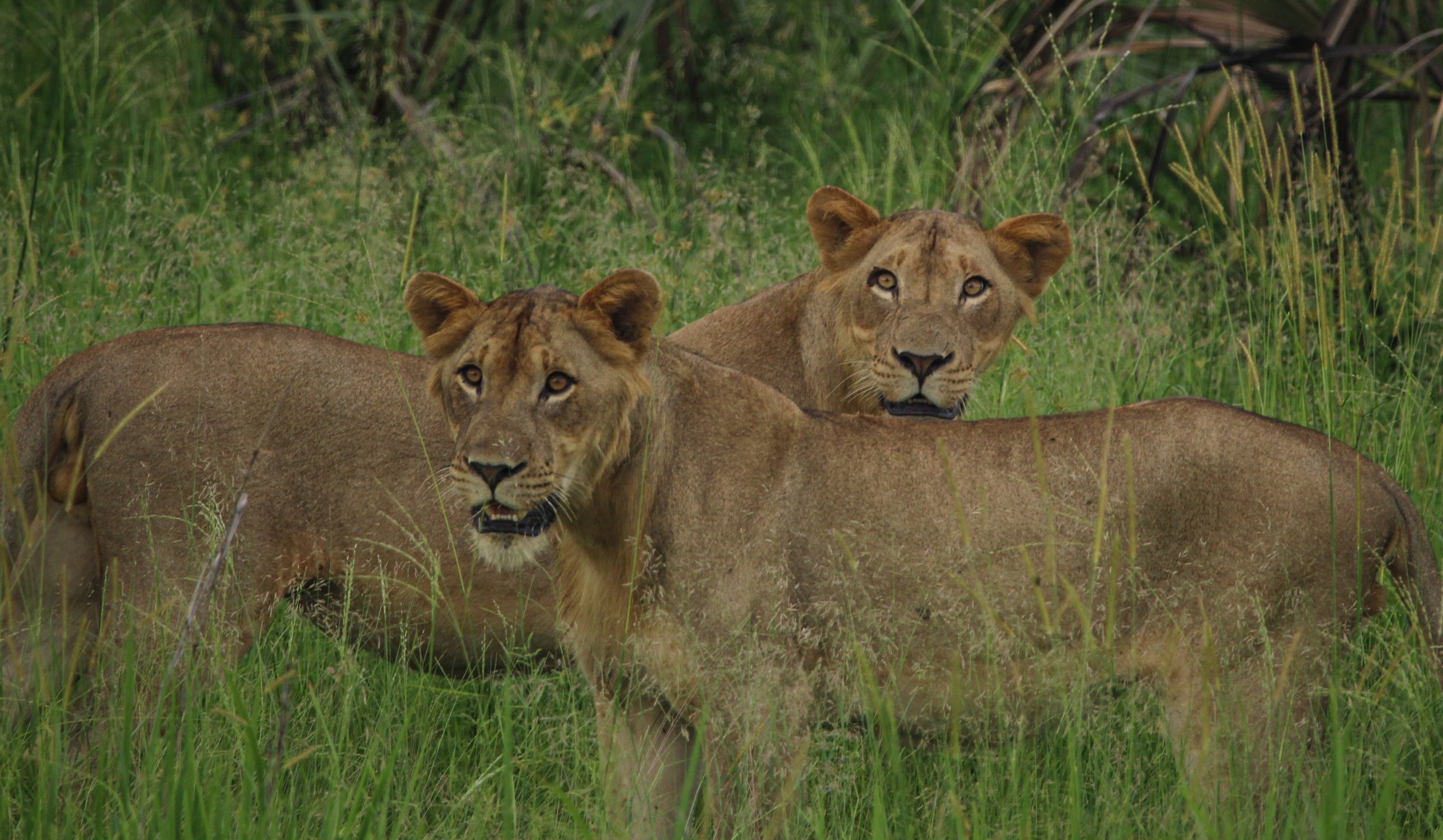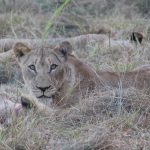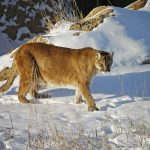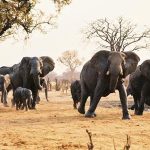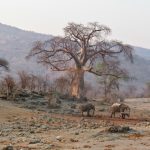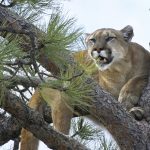An Update on Mozambique’s 24 Lions Project
Photo above by Mark Haldane
In 2018, Brad Fitzpatrick first reported in Sports Afield about a project he termed “the largest wild lion transfer across an international border in African history.”
The brainchild of safari outfitter/professional hunter Mark Haldane, who worked with partners including neighboring concession holder Alvaro Rola and the Ivan Carter Wildlife Conservation Alliance, the 24 Lions Project was a year’s long undertaking in the planning that resulted in the transportation and reintroduction of lions back into the Zambezi Delta area of Mozambique, with little precedent and no practical model for predicting success. Made possible by funding from the Cabela Family Foundation, the project just celebrated its third anniversary. I was in Mozambique recently to find out how things were going.
As we buzzed high over the Zambezi Delta, I felt like I was wearing the tiny R-22 helicopter more than flying in it. Mark Haldane, Zambeze Delta Safaris owner, and I were flying out in search of one of the lion prides wandering the one million acres of revitalized Mozambiquan wilderness known as Coutada 11. Would we be successful in finding the elusive top-tier predator? We would know in 30 minutes or so.
From interviews with the head of the scientific team, Willem Briers-Louw, as well as Haldane himself, I had already learned that some of the original 24 lions released three years ago in Coutadas 10 and 11 had died from natural causes or through poaching.
The good news was that those who survived had quickly disbursed across the vast landscape and established eight prides from which 24 lions had today grown to 60 cats strong.
On our flight today, Haldane and I were searching for the most successful single pride of the project, a group known as the Tembe Pride.
The Disappearing Act of the Tembe Pride
Spotting a pride of lions in their native landscape is not as easy as it sounds, even from the vantage point of a helicopter. In fact, the very same pride that Haldane and I were trying to locate today had a knack for staying out of sight.
Named after their point of origin, Tembe Elephant Park in South Africa, the Tembe Pride – originally consisting of four females – disappeared for an entire year after release from the wire-and-wood acclimatization boma where they were held upon arrival in Mozambique. Though a fair proportion of the 24 introduced lions wore electronic collars, there were not enough to go around, and none of the Tembe lionesses sported a collar.
There was good reason to be concerned for the safety of the Tembe lions after their release. Humans and their traps and snares were the main cause of death among the original 24 animals. Though the anti-poaching efforts of the hunting operators in the region have been wonderfully successful, the same is not true for adjoining areas. Had the Tembe females wandered out of the hunting area and into the poachers’ gin traps and metal snares? As the months went past, it seemed more and more likely that the four Tembe lionesses were not just missing, but dead.
The break in the case of the disappeared Tembe pride came like all good detective yarns, involving an unexplained observation. Briers-Louw and his colleagues had noticed for some time that lions were making kills in a localized area – frequently from the many warthogs occupying the floodplains. However, the scientists were unsuccessful in spotting any lions in this region, either from the ground or the air. The million dollar question was: Which pride was responsible for the kills?
Then one day the guides were driving out to the floodplain in the late afternoon to relax and have a sundowner. The last thing on their minds was spotting the Tembe Pride, but as they rounded a patch of vegetation, not 150 yards away outlined against the brilliant red horizon were the four missing-in-action lionesses. The scientists now knew that the Tembe pride had survived, and importantly, they were able to dart and collar two of the females so they could now keep tabs on the pride’s whereabouts.
Within a week of their rediscovering the Tembe Pride, the scientists realized that a resident Mozambiquan male lion was with them, and, remarkably, two of the females were carrying cubs. Within a few months, the two pregnant females formed a den nearby in a place nicknamed Beto’s Island. When the scientists checked on the two females a short time later, they discovered not only the lionesses, but also seven chubby, rollicking young cubs. A few months later a third female gave birth to two cubs, and then not long afterwards, the fourth and last female produced a single offspring. The Tembe Pride now boasts the original four lionesses and 10 half- to two-thirds grown cubs.
The Hapless Karongwe Pride
If Tembe is the most successful group from the original 24 Lions reintroduction, the Karongwe Pride is the one that has been through the greatest struggles, including several tragedies. The two Karongwe lionesses making up this pride came from the Karongwe Animal Preserve near Kruger National Park. The two females failed to produce cubs the first year after their release. With other lionesses able to reproduce, Briers-Louw and his team wondered whether or not the females might be infertile.
The concern over the lack of conception soon took a backseat to the possibility that one of the females might die. On one of his helicopter patrols, Haldane happened to cross over into a neighboring area. He spotted one of the Karongwe females wandering there, and noticed that she seemed to be in some sort of difficulty. When Mark radioed his camp for help, the scientists and veterinarians rushed to the area and found the lioness with a snare encircling her body. Its ever-tightening construction had buried the snare to a depth of two inches beneath her skin. Neither the scientists nor veterinarians gave the lioness much chance of survival, but they cleaned the wound, closed the horrible gash with surgical thread and injected her with a large dose of antibiotics. Then they put a GPS collar on her in order to monitor her closely and see if she would recover.
The good news was that the lioness did indeed heal and regain full health. The bad news was that within the month she and her companion lioness returned to the same area, and she once again found herself in a poacher’s wire snare. This time, the snare lodged just above her back left paw. The signals from the lioness’ GPS collar tipped off the crew that she was not moving. The scientists and veterinarian again loaded into the helicopter and made their way to the struggling Karongwe female. When they reached her, they quickly used the hypodermic dart to put her to sleep. Once sedated, they rolled her over and found her back foot swollen to more than double normal size. Left much longer, they would have had no option but to amputate the damaged foot – a not uncommon ending for these types of injuries. Such an amputation could easily have resulted in her removal from the Delta, or eventual euthanasia. But this lioness continued to demonstrate a cat’s nine lives. As she limped away, the team of concerned watchers could only wonder if she would eventually succumb to her unwise wanderings.
While the one Karongwe lioness repeatedly encountered the poachers’ cruelty, the other lioness was having her own tragic struggles. Unlike her companion, the second female from the Karongwe Animal Preserve had been fortunate to avoid poachers. The scientific team was ecstatic when they caught up with her one year after her release and found the lioness playing with her young cub. Unfortunately, their joy was short-lived. Three months later, they located the female, and her cub was no longer with her. Briers-Louw and his team are quick to point out that such losses are “part of the process.” Yet, the catch in their voices when discussing such events communicates the level of pain that such ”natural occurrences” cause for those so invested in the individual animals of the 24 Lions project.
The plight of the Karongwe females continued after the near-loss of one female and the loss of the second female’s first offspring. Six months after the death of the cub, the GPS collars indicated that both females were together and excitingly were showing ”denning behavior,” venturing out and making kills in a small radius and otherwise limiting their movements.
When the scientists headed out in their helicopter in search of the Karongwe lionesses, they had high hopes of finding the females with more cubs. They were not disappointed. As the helicopter hovered, the two females and a total of four cubs looked up warily at the noisy contraption. One cub belonged to the female who came close to losing her life to snares. The second female had replaced her lost cub with three more young. Sadly, these births also ended in loss. In only a few months, the lionesses’ limited movement patterns – short distances traveled back-and-forth from their den – once again widened to that of adult animals without young. Sure enough, when the team again located the two Karongwe females, they were both cubless.
Then, in August 2020, the Karongwe Pride’s story finally took a turn for the better. The females moved into a game-rich and poacher-free floodplain. Maybe the females’ instincts were changing or maybe they were just beginning to understand the landscape of their new home in Mozambique, but whatever the reason, with the abundance of game, the females became pregnant and each had a litter of three cubs. Though early on, the snared female lost one of her cubs, the remaining five are now 11 months old, and well on their way to becoming adults. The other great news is that one of the dominant males from the original 24 animals has joined the Karongwe females and is acting as the guardian of both lionesses and cubs. Yes, compared to the Tembe Pride, the Karongwe lionesses have traveled a troubled path. But, maybe, just maybe, they have turned a corner.
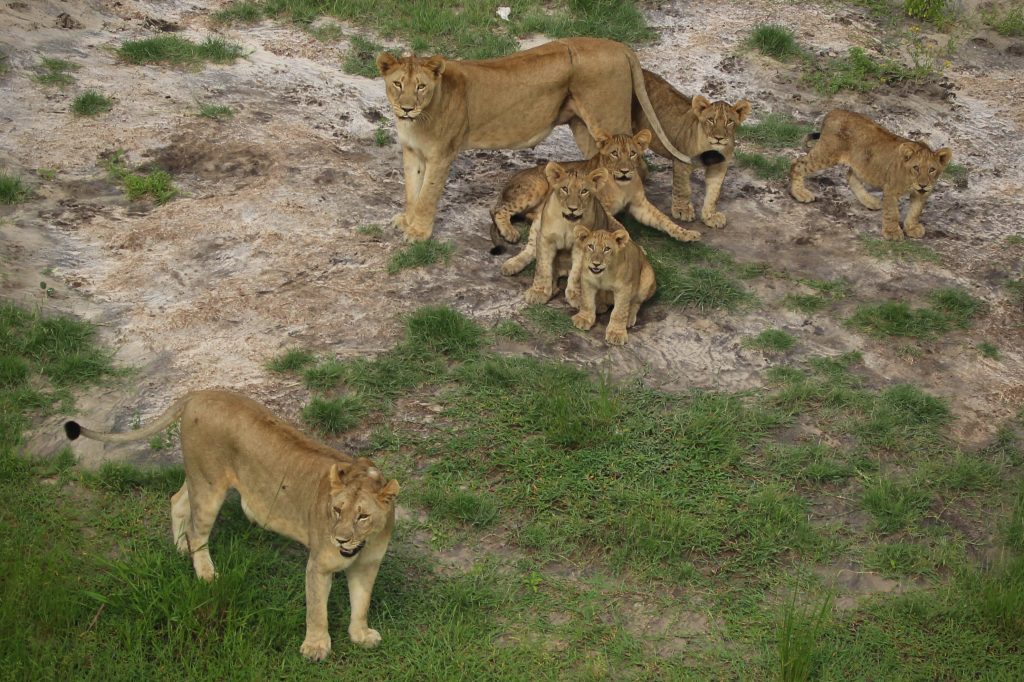
Stunning Success of the 24 Lions Project
As the travails of the Karongwe Pride indicate, the reintroduction begun in 2018 was not without its challenges. In total, seven of the original 24 adult lions released into the Marromeu Complex died in the first three years. During this same period, 51 births occurred, with nine of the cubs lost. Yet, in a wonderful demonstration of the marriage of great science, substantial funds, and the passion of hunters, the 24 lions introduced in 2018 have nearly tripled in number. Even the number of prides has increased, with the Mac group replicating into three separate active prides. Yes, there has been loss of adults and young to natural causes and poaching, but looked at from all perspectives, the reintroduction has been an incredible success.
Our helicopter trip was wildly successful too. As our search for the Tembe Pride continued under Haldane’s piloting, my heart and breathing rate elevated. Finally, we homed in on the GPS coordinates issuing from the Tembe lions’ GPS collars. And then, there they were below us. Staring up with what looked through the camera lens like irritation mixed with disdain – as if they were thinking, “Here come the bloody tourists again!” – they slowly, slowly slunk from one palmetto patch to the next. Their tawny hides had an iridescent quality in the rays of the morning sun. As they meandered between the temporary hiding places, their muscles rippled and their detachable shoulder blades slid to-and-fro. Simply put, they were animals that left me speechless.
Not wanting to overly upset the lions or overstay our less-than-warm welcome, we left the pride to its wanderings after only 10 minutes. As Mark turned the helicopter back toward the Zambeze Delta Safaris basecamp, I sat in amazement from what I had just experienced. Wild lions are disappearing at an alarming rate across Africa. Not as a result of trophy hunters, but mostly because they get in the way of local humans and suffer the consequences. That trend is not true for the Marromeu Complex under the watchful eyes of hunters and scientists. The number of lions there is increasing at an astonishing rate and they are dispersing across millions of acres of woodland and floodplain. Wild lions have returned and made themselves at home in Mozambique’s Zambezi Delta, thanks to a small group of dedicated people and the vision they share.

